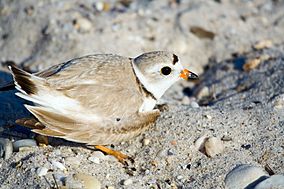Quill Lakes facts for kids
Quick facts for kids Quill Lakes |
|
|---|---|

A piping plover running on a beach
|
|
| Area | 635 square kilometres (245 sq mi) |
| Designated: | 27 May 1987 |
| Reference #: | 365 |
The Quill Lakes are a group of three special lakes in Saskatchewan, Canada. They are called Big Quill Lake, Middle Quill Lake, and Little Quill Lake. These lakes are a type of wetland, which is an area of land covered by water.
On May 27, 1987, these lakes were named a 'wetland of international importance' by something called the Ramsar Convention. This means they are super important for nature around the world. They were also the first Canadian place chosen for the North American Waterfowl Management Plan.
Contents
Discover the Quill Lakes
The Quill Lakes got their name because people used to collect bird quills near the shore. These quills were then sent to England to be made into quill pens.
The Quill Lakes make up Canada's largest salt lake system. They cover a huge area of about 635 square kilometres (245 sq mi). The amount of salt in the water changes, which affects what kinds of plants can grow there.
Where are the lakes located?
The lakes are located north of Regina and east of Saskatoon. Most of the land around the lakes is owned by the government. The area around the lakes has hills formed by glaciers and is mostly used for farming.
Big Quill Lake is shaped like a pear and is about 27 km long. At its widest point, it measures 18 km across. Middle Quill Lake, also known as Mud Lake, is the smallest. It is about 6 km long and 3 km wide. Little Quill Lake is 24 km long and 11 km wide.
Special islands for birds
Some islands in Middle Quill Lake are protected areas for wildlife. This helps to keep safe the breeding places for birds like the American white pelican and the double-crested cormorant.
Amazing Bird Life
The Quill Lakes are a very important place for birds. Many different types of birds stop here to rest and eat during their long migrations. They also come here to build nests and raise their young.
The lakes are known as an Important Bird Area. This is because they have large numbers of migrating and breeding birds that are important both in Canada and around the world.
Bird populations and studies
Scientists have studied the bird populations at the Quill Lakes many times. In 1988, a study counted 155,000 shorebirds at Big Quill Lake. Between 1989 and 1992, other studies found over 100,000 birds on Middle and Little Quill Lakes in a single day.
The biggest study of all three lakes counted 197,155 birds! This shows just how many birds rely on this special place.
Endangered birds and other species
The Quill Lakes are a key spot for the endangered piping plover. This small shorebird needs safe places to stop and breed.
Many other bird species have been seen here, including:
- 85,000 geese
- 100,000 ducks
- 12,000 cranes
- Black-bellied plovers
- Sanderlings
- Hudsonian godwits
- Red knots
- Stilt sandpipers
- White-rumped sandpipers
- Semipalmated sandpipers
- Long-billed dowitchers
- Red-necked phalaropes
- Lesser yellowlegs
In the mid-1990s, some whooping cranes were also seen using the area during their fall migration.
Challenges for the Lakes
The water levels and saltiness of the Quill Lakes can change a lot.
- When there is a drought (a long period with no rain), less water flows into the lakes. This makes the water level drop and the lakes become saltier. This can make it harder for birds like the piping plover to find good places to breed.
- Since 2005, there has been a lot of rain, causing the lake levels to rise by 7 meters. This has led to widespread flooding in the area.
What is extracted from the lakes?
A company operates near Big Quill Lake. They take out a natural salt called sulphate from the lake's salty water. This sulphate is then mixed with another material to create a special fertilizer. This fertilizer is then sold to farmers.

